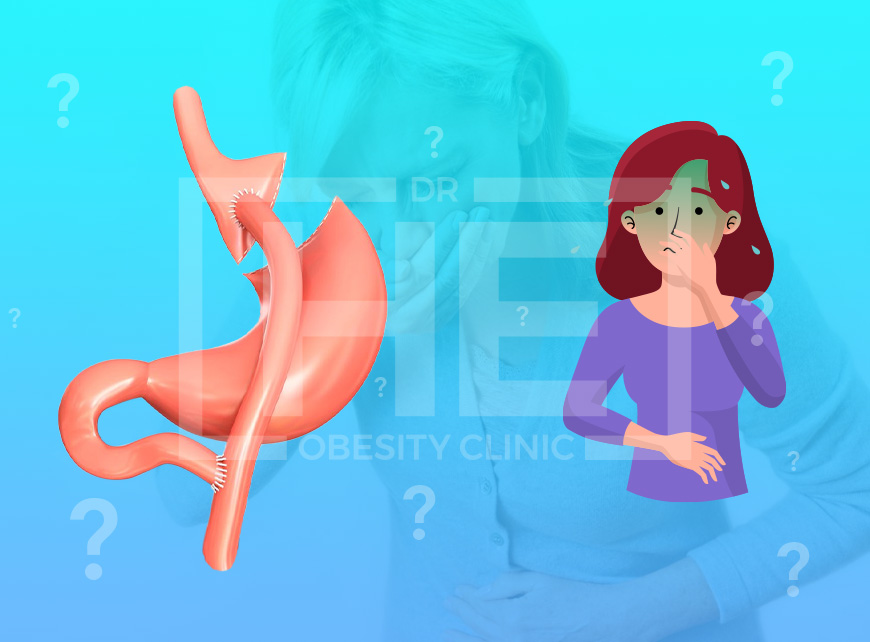What is candy cane syndrome? Candy cane syndrome symptoms, candy cane limb syndrome, candy cane syndrome gastric bypass, What are the symptoms of candy cane syndrome? Candy cane syndrome after gastric bypass, How to treat candy cane syndrome? What causes candy cane syndrome? Candy Cane Syndrome: Symptoms and Treatment This syndrome is believed to be the cause of abdominal pain, nausea, and vomiting after Roux-en-Y gastric bypass surgery, but its description is still poor. This case series shows that the Candy Cane syndrome is real and can be effectively treated with bariatric surgery.
Candy cane syndrome is a real phenomenon that disappears after removal of the blind afferent limb. Thorough diagnosis is essential to correctly identify this syndrome. This syndrome can be treated with revision surgery and removal of afferent limbs. Candy Cane Syndrome in patients undergoing Roux-en-Y gastric bypass surgery refers to the presence of excessively long blind passages into Roux’s limbs during gastrojejunostomy, resulting in postprandial pain, which is usually relieved by vomiting. Blind afferent limbs (“candy canes”) are believed to act as a blocked ring when filled with food (usually preferred), and the expansion of the ring can cause pain until the food spills into Roux’s limb or vomits.
Candy cane syndrome is a rare complication that can occur after Roux-en-Y gastric bypass surgery, a type of weight loss surgery that reduces the size of the stomach and bypasses part of the small intestine. Candy cane syndrome is caused by an excessively long blind end of the Roux limb, the part of the intestine that is attached to the stomach pouch. This blind end can trap food and cause symptoms such as nausea, vomiting, abdominal pain, acid reflux, and poor weight loss. Candy cane syndrome can be diagnosed by using imaging tests, such as upper gastrointestinal series or computed tomography scan, that can show the length and shape of the Roux limb. Endoscopy can also be used to visualize the inside of the stomach and the intestine, and to rule out other possible causes of the symptoms.
The treatment of candy cane syndrome usually involves removing the excess blind end of the Roux limb, either surgically or endoscopically. Surgical resection can be done laparoscopically or open, and it involves cutting and reattaching the Roux limb to the stomach pouch. Endoscopic resection can be done by using special devices, such as sutures or clips, to close off the blind end and redirect the food flow to the main Roux limb. Both surgical and endoscopic treatments have been reported to be effective in relieving the symptoms and improving the weight loss of the patients with candy cane syndrome. However, endoscopic treatment may have some advantages over surgical treatment, such as being less invasive, less risky, and less costly. Endoscopic treatment may also be more suitable for patients who have high surgical risk or who do not want to undergo another surgery. Candy cane syndrome is a preventable complication that can be avoided by ensuring a short and straight Roux limb during the primary gastric bypass surgery. Therefore, it is important for the surgeons to be aware of this condition and to follow the appropriate surgical techniques. It is also important for the patients to be informed of this possibility and to seek medical attention if they experience any of the symptoms.
Recommended content: Gastric Sleeve Turkey
What is Candy Cane Syndrome?
What is candy cane syndrome? Candy cane syndrome, also known as superior mesenteric artery syndrome, is a rare and potentially serious medical condition that affects the digestive system. This condition occurs when the duodenum, which is the first part of the small intestine, becomes compressed between two major blood vessels: the aorta and the superior mesenteric artery. This compression can lead to a range of symptoms, including severe abdominal pain, nausea, vomiting, and weight loss.
The name “candy cane syndrome” comes from the way the compressed duodenum resembles the shape of a candy cane on imaging studies such as X-rays or CT scans. This compression can disrupt the normal flow of food and liquid through the digestive system, leading to a variety of gastrointestinal symptoms. While the exact cause of candy cane syndrome is not always clear, it is often associated with rapid weight loss, such as that which occurs after bariatric surgery or during prolonged illness.
Symptoms of candy cane syndrome can vary depending on the severity of the compression and may include:
1. Severe and persistent abdominal pain, especially after eating
2. Nausea and vomiting
3. Feeling full quickly while eating
4. Weight loss
5. Acid reflux
6. Malnutrition
Diagnosing candy cane syndrome can be challenging, as the symptoms can be similar to those of other gastrointestinal conditions. However, imaging studies such as X-rays, CT scans, or barium swallow studies can help identify the compression of the duodenum between the aorta and the superior mesenteric artery. Additionally, a thorough medical history and physical examination are important for ruling out other potential causes of the symptoms.
Treatment for candy cane syndrome aims to relieve the compression of the duodenum and alleviate symptoms. This may involve conservative measures such as dietary modifications to avoid exacerbating symptoms, as well as nutritional support to address any malnutrition or weight loss. In some cases, surgical intervention may be necessary to release the compression and create more space around the duodenum.
It’s important for individuals experiencing symptoms of candy cane syndrome to seek medical attention promptly, as untreated cases can lead to complications such as severe malnutrition, dehydration, and electrolyte imbalances. With appropriate management, many individuals with candy cane syndrome can experience significant improvement in their symptoms and quality of life.
Candy cane syndrome is a rare but potentially serious condition that involves compression of the duodenum between two major blood vessels in the abdomen. Recognizing the symptoms and seeking prompt medical evaluation are crucial for effectively managing this condition and preventing complications.
Candy Cane Syndrome
Candy Cane Syndrome is a rare and underreported complication that can occur after Roux-en-Y gastric bypass surgery, a type of weight loss surgery that involves creating a small pouch from the stomach and connecting it to a part of the small intestine, bypassing the rest of the stomach and the duodenum. This surgery helps people lose weight by limiting the amount of food they can eat and reducing the absorption of calories and nutrients.
However, Candy Cane Syndrome can cause abdominal pain, nausea, vomiting, and poor weight loss or weight regain in some patients. It results from an excessively long blind end of the small intestine, also known as the afferent limb, at the site of the connection between the stomach and the intestine, also known as the gastrojejunostomy. This blind end forms a hook-like shape that resembles a candy cane, and can trap food and fluids, creating a blockage or obstruction. This can lead to inflammation, ulceration, infection, or perforation of the intestine, and can also interfere with the normal flow of food and digestive juices.
The diagnosis of Candy Cane Syndrome can be challenging, as it can mimic other conditions, such as gastritis, ulcers, gallstones, or dumping syndrome. The diagnosis can be confirmed by several tests, such as upper gastrointestinal endoscopy, barium swallow study, esophageal manometry, or pH monitoring. These tests can show the presence and size of the blind end, and how it affects the passage and digestion of food and liquids.
The treatment of Candy Cane Syndrome depends on the severity of the symptoms and the extent of the complication. Some patients may benefit from conservative measures, such as dietary modifications, medications, or endoscopic interventions. These can help relieve the symptoms, reduce the inflammation, and prevent further complications. However, some patients may require surgical revision, which involves removing the blind end and creating a new gastrojejunostomy. This can resolve the obstruction, improve the digestion, and enhance the weight loss.
Candy Cane Syndrome is a real and serious complication that can occur after Roux-en-Y gastric bypass surgery. It can cause significant morbidity and mortality, and impair the quality of life and the weight loss outcomes of the patients. Therefore, it is important to be aware of this complication, and to seek medical attention if any symptoms arise. Early diagnosis and treatment can prevent further damage and improve the prognosis.
Candy Cane Syndrome Symptoms
Candy cane syndrome symptoms; Candy cane syndrome, also known as superior mesenteric artery syndrome, is a rare and potentially serious condition that affects the digestive system. This syndrome occurs when the duodenum, which is the first part of the small intestine, becomes compressed between two major blood vessels in the abdomen – the aorta and the superior mesenteric artery. This compression can lead to a range of uncomfortable and sometimes debilitating symptoms.
One of the most common symptoms of candy cane syndrome is severe and chronic abdominal pain. This pain is typically located in the upper abdomen and can be triggered or exacerbated by eating. The pain may come and go, or it may be constant and unrelenting. Some individuals with candy cane syndrome also experience nausea and vomiting, particularly after eating. These symptoms can lead to weight loss and malnutrition if not properly managed.
In addition to abdominal pain, individuals with candy cane syndrome may also experience bloating, early satiety, and a feeling of fullness after only small amounts of food. This can make it difficult to maintain a healthy and balanced diet, leading to further complications. Some people may also notice visible distention or swelling in the upper abdomen, which can be distressing and uncomfortable.
Other symptoms of candy cane syndrome can include difficulty swallowing, particularly if the compression of the duodenum is severe. This can lead to a sensation of food getting stuck in the throat or chest, which can be frightening and may contribute to further dietary restrictions. In severe cases, individuals may also experience episodes of intestinal obstruction, which can cause intense abdominal pain, vomiting, and constipation.
The exact cause of candy cane syndrome is not always clear, but there are several factors that can contribute to its development. One common cause is rapid weight loss or significant changes in body composition, which can alter the positioning of the blood vessels in the abdomen. Trauma or surgery in the abdominal area can also lead to the development of candy cane syndrome. Additionally, certain anatomical variations or abnormalities in the blood vessels themselves can predispose individuals to this condition.
Diagnosing candy cane syndrome can be challenging, as it is a relatively rare condition and its symptoms can mimic those of other digestive disorders. However, imaging studies such as CT scans or barium swallow tests can help to visualize the compression of the duodenum and confirm the diagnosis. In some cases, an upper endoscopy may also be performed to rule out other potential causes of the symptoms.
Treatment for candy cane syndrome typically focuses on addressing the underlying cause of the duodenal compression and alleviating symptoms. In mild cases, dietary modifications such as eating smaller, more frequent meals and avoiding foods that exacerbate symptoms may be sufficient. In more severe cases, nutritional support through enteral or parenteral feeding may be necessary to prevent malnutrition. In some instances, surgical intervention may be required to relieve the compression on the duodenum and restore proper digestive function.
Candy cane syndrome is a complex and challenging condition that can significantly impact an individual’s quality of life. It requires careful management and a multidisciplinary approach involving gastroenterologists, dietitians, and surgeons to ensure the best possible outcomes for affected individuals. By raising awareness of this syndrome and its symptoms, healthcare providers can work towards earlier recognition and intervention, ultimately improving the lives of those living with candy cane syndrome.
Candy Cane Limb Syndrome
Candy cane limb syndrome; Candy cane limb syndrome is a rare condition that affects the blood vessels in the arms and legs, causing them to take on a distinctive red and white striped appearance, resembling a candy cane. This condition is also known as segmental arterial mediolysis (SAM) and is characterized by the sudden weakening and subsequent narrowing of the arteries, leading to reduced blood flow to the affected limbs.
The exact cause of candy cane limb syndrome is not fully understood, but it is believed to be related to damage or injury to the blood vessel walls, possibly as a result of trauma, surgery, or certain medical procedures. This damage can lead to the formation of aneurysms, or bulges in the blood vessels, which can then rupture or tear, causing internal bleeding and the characteristic striped appearance of the affected limbs.
Symptoms of candy cane limb syndrome can vary depending on the severity of the condition, but may include pain, numbness, weakness, and a noticeable change in the color and temperature of the affected limbs. In some cases, individuals with this condition may also experience complications such as tissue damage, ulcers, and even gangrene if the blood flow to the limbs is severely compromised.
Diagnosing candy cane limb syndrome can be challenging, as it is a rare condition and its symptoms can mimic those of other vascular disorders. However, imaging tests such as ultrasound, CT scans, and angiography can help to identify the characteristic arterial changes associated with this condition. It is important for individuals experiencing symptoms of candy cane limb syndrome to seek medical attention promptly in order to receive an accurate diagnosis and appropriate treatment.
Treatment for candy cane limb syndrome typically involves addressing the underlying arterial damage and managing any associated complications. This may include medications to control blood pressure and prevent blood clots, as well as surgical interventions to repair or bypass damaged blood vessels. In some cases, individuals with severe candy cane limb syndrome may require amputation of the affected limbs in order to prevent further complications.
While there is currently no cure for candy cane limb syndrome, ongoing medical research is focused on better understanding the underlying causes of this condition and developing more effective treatments. In the meantime, individuals with candy cane limb syndrome can benefit from working closely with a team of healthcare providers to manage their symptoms and minimize the impact of this rare vascular disorder on their quality of life.
Candy cane limb syndrome is a rare and potentially serious condition that affects the blood vessels in the arms and legs, leading to distinctive red and white striped discoloration and a range of associated symptoms. While the exact cause of this condition remains unclear, early diagnosis and appropriate medical management are crucial for individuals affected by candy cane limb syndrome in order to minimize complications and improve outcomes. Ongoing research into this rare vascular disorder offers hope for improved understanding and treatment options in the future.
Candy Cane Syndrome after Gastric Bypass
One finding after gastric bypass is Candy Cane gastric bypass. Nausea, vomiting, and epigastric pain are common complaints in patients undergoing RNY gastric bypass surgery. In addition, the incidence of patients with complications of weight rebound or dumping syndrome is high.
The symptoms of nausea, vomiting, and epigastric pain in patients with a history of gastric bypass surgery are often evaluated by the primary care center and referred to a gastroenterologist.
The recommended “routine” examination is an abdominal X-ray examination, possibly a contrast examination and of course upper gastrointestinal endoscopy. A common and unreported problem may be Candy Cane’s discovery.
The “blind” end of the small intestine anastomosis is too long, causing food to settle on the candy cane hook. Symptoms of nausea, vomiting, and epigastric pain may be due to residual food and fluid not being drained from the area.
How to treat candy cane syndrome?
The most common bariatric surgery is Roux-en-Y gastric bypass (RYGB) and is associated with early and late complications. These complications are usually diagnosed and treated by endoscopy, including anastomotic stenosis, marginal ulcers, leaks and fistulas.
We describe a patient with little-known complications after RYGB. A 57-year-old woman accepted RYBB in 2003 without accident. She had a history of nausea and vomiting for 4 to 5 months after 9 years. He also reported pain in the upper abdomen and upper left abdomen, as well as symptoms of GERD.
His weight before the operation was 315 pounds, which was reduced to about 219 pounds a year. Now he is back at 263 pounds and has a BMI of 42.5. Before her visit, she had received a simple EGD from an external gastroenterologist. Studies of the upper gastrointestinal tract showed no evidence of leakage or obstruction.
Repeat EGD at our institution showed 2 cm hiatus hernia, grade A LA esophagitis, 7 cm gastric pouch and gastrojejunostomy, as well as the Roux cercal tip extending approximately 8 cm proximal to the gastrojejunostomy (“candy cane”).
Subsequently, the patient underwent laparoscopic surgery, repaired two accidental mesenteric hernias, and removed the Roux big blind branch of the jejunum 10-12 cm in length. The patient’s nausea and vomiting disappeared immediately.
During the one-month follow-up, her stomach pouch worked well, she lost 18 pounds, and her symptoms did not recur. Roux Candy Cane syndrome was described as a complication of RYGB in 2007, in which the proximal non-functional Roux limb of the gastrojejunostomy was too long.
Only 4 cases are described in the literature. With the increase in gastric bypass surgery, this syndrome may be more common than previously established.
Since the gastroenterologist may be the first referral provider to evaluate symptomatic patients after gastric bypass, when performing upper gastrointestinal endoscopy, one should recognize this complication and explore Roux’s blind limb, especially this is when there is no abnormality in the imaging examination. In addition, gastric pouch inflation is also very important for diagnosis.




 Türkçe
Türkçe  Deutsch
Deutsch  Français
Français  Español
Español  Русский
Русский  Nederlands
Nederlands  български
български  Português
Português  Română
Română  العربية
العربية






